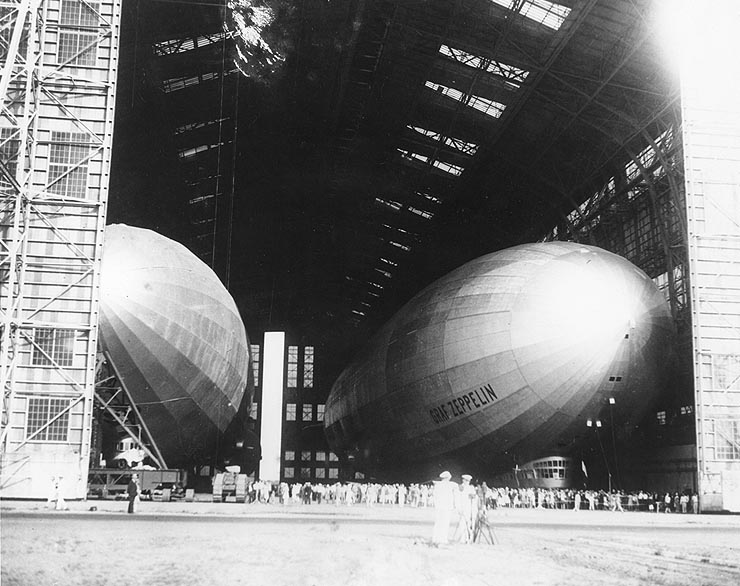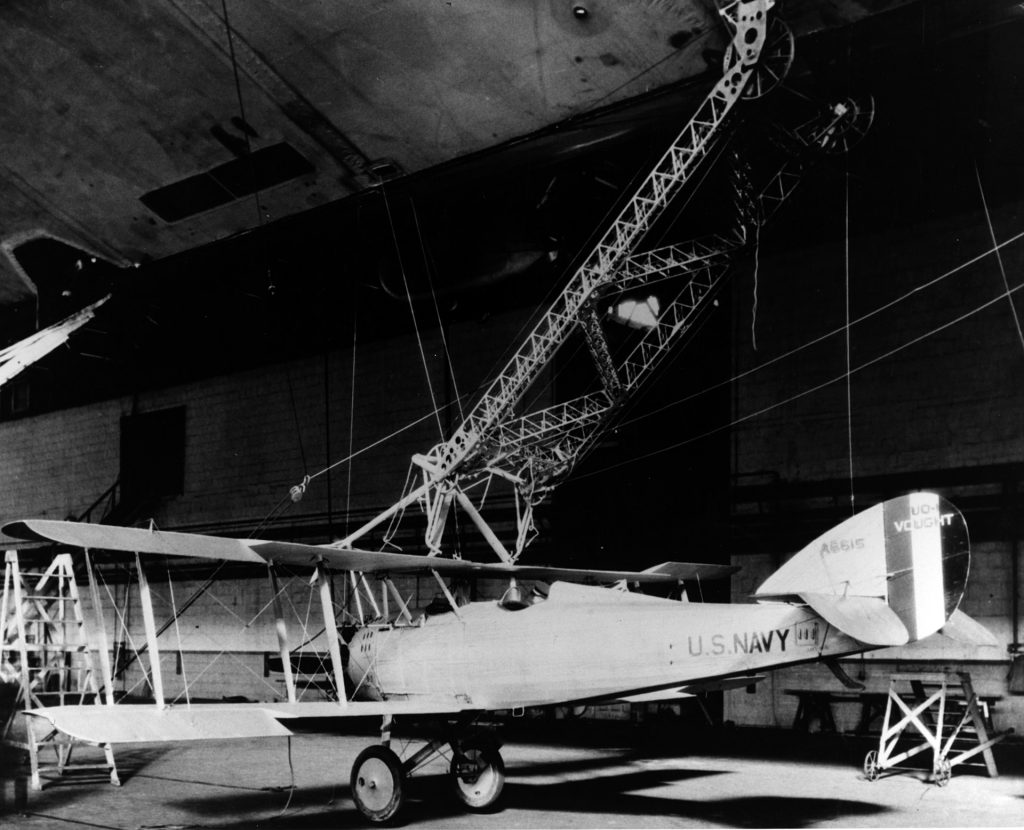
Commissioned in the 1920s, it played a pivotal role in the development of airship operations, techniques, and naval aviation strategies.
Despite its significant contributions, the rise of airplane technology and a series of high-profile airship accidents eventually led to its decommissioning in the 1930s.
Origins And Design
The early 20th century saw the rise of airships as a novel and promising mode of transportation and warfare. Post-World War I geopolitics and the subsequent Treaty of Versailles played an unexpected role in the story of the USS Los Angeles.
The treaty, which aimed to establish peace and redraw the global map after the devastating war, imposed numerous conditions on Germany, the primary aggressor.
Among these conditions were reparations, not only in the form of monetary payments but also technological assets. This was where the LZ 126, an advanced zeppelin, entered the equation.
Built by the renowned Zeppelin Company in Germany, the LZ 126 was one of the most advanced airships of its time. Under the guidance and expertise of Dr. Hugo Eckener, an aeronautical engineer and leading figure in the world of airships, the LZ 126 was envisioned to serve the German Navy.
 USS Los Angeles and Graf Zeppelin in a hangar at NAS Lakehurst, New Jersey.
USS Los Angeles and Graf Zeppelin in a hangar at NAS Lakehurst, New Jersey.
Its design was characterized by an intricate blend of the latest aerodynamic principles, robust construction, and innovative materials. The primary material, duralumin, a strong yet lightweight alloy, gave the airship its formidable structure.
Spanning a length of 658 feet, with a diameter nearing 80 feet, the LZ 126 was not only an engineering marvel but also a majestic sight in the skies.
However, with Germany’s defeat, the airship’s fate took a different turn. As part of the war reparations outlined in the Treaty of Versailles, the LZ 126 was handed over to the United States in 1924. Recognizing its potential, the U.S. Navy quickly adopted and rechristened it as the USS Los Angeles, giving it the designation ZR-3
Operational History Of The USS Los Angeles
Stationed at the Naval Air Station Lakehurst in New Jersey, a hub of airship activities, the USS Los Angeles was poised to showcase the potential of lighter-than-air vessels in a variety of roles.
From the outset, the USS Los Angeles was more than just a stationary symbol; it was an active and agile vessel, undertaking diverse missions that demonstrated the versatility of airships. One of its most acclaimed undertakings was the cross-country flight in 1925.
This journey wasn’t merely a relocation exercise but a clear testament to the long-distance capabilities of airships.
During this flight, the USS Los Angeles traversed from its base in Lakehurst to the West Coast of the United States, effectively showcasing the potential of airships for transcontinental journeys, a concept novel for its time.
Beyond long-distance demonstrations, the USS Los Angeles was deeply involved in experimental missions that explored the integration of airships with broader naval operations.
A revolutionary idea of its time was to understand if airships could be docked to battleships in open waters. Such exercises were conducted to evaluate the feasibility of using airships as aerial platforms for reconnaissance, providing naval fleets an eye in the sky.
 USS Los Angeles in Washington DC, 1924.
USS Los Angeles in Washington DC, 1924.But the USS Los Angeles wasn’t just about showcasing potential; it was also instrumental in developing the human resources of the Navy. The airship served as a valuable training ground for naval aviators, offering them firsthand experience in the nuances of airship navigation, operation, and maintenance.
Through hands-on training aboard the Los Angeles, a generation of naval aviators gained insights into the intricacies of airship handling, ensuring the legacy and lessons of the vessel were passed down.
Yet, despite its active operational role, what set the USS Los Angeles apart from some of its contemporaries, like the USS Akron and USS Macon, was its relatively accident-free record.
While other naval airships faced tragic incidents that highlighted the risks of airship operation, the USS Los Angeles stood out as an exemplar of safe and efficient operation.
Challenges And Innovations Of The USS Los Angeles
In 1927, the USS Los Angeles faced a formidable challenge while moored at its base. A sudden and fierce gust of wind caught the massive structure of the airship, causing it to elevate tail-first, resulting in an alarming vertical position.
This precarious situation not only posed immediate risks to the structure of the airship but also highlighted the vulnerabilities in mooring techniques of the time. Such incidents were not exclusive to the Los Angeles; airships were prone to being affected by unpredictable weather, given their large surface area and the inherent buoyancy of their design.
 A sudden arrival of cold air caused the tail of the airship to rise.
A sudden arrival of cold air caused the tail of the airship to rise.
However, what followed this incident showcased the spirit of innovation within the U.S. Navy. Recognizing the dangers of traditional mooring methods, new techniques and infrastructure modifications were introduced.
These changes aimed at securing airships more effectively against capricious weather elements, ensuring that such dangerous incidents could be minimized in the future.
Innovation aboard the USS Los Angeles was not limited to reactive measures alone.
The airship was often at the forefront of groundbreaking experiments, pioneering developments that sought to redefine the utility of airships.
One such pioneering experiment was the exploration of the “spider” and “trapeze” systems.
 Vought UO-1 observation plane attached to the trapeze system of the Los Angeles during testing in 1928.
Vought UO-1 observation plane attached to the trapeze system of the Los Angeles during testing in 1928.
This system was a revolutionary concept where airplanes could, while in mid-flight, hook onto an airship.
The potential implications were profound: airships could potentially act as aerial aircraft carriers, launching and recovering airplanes in the skies.
Such a concept could radically enhance the operational range and capabilities of naval air forces, offering strategic advantages in both reconnaissance and combat scenarios.
Decommissioning
By the mid-1930s, the world of aviation was undergoing rapid transformation. The advent of more reliable and powerful airplane technology began to eclipse the significance of airships.
The advantages that airplanes offered in speed, flexibility, and payload capacity increasingly overshadowed the operational benefits of airships.
Additionally, the naval aviation landscape was marred by high-profile airship tragedies, such as the accidents involving the USS Akron and USS Macon.
These incidents cast a shadow over the perceived safety and viability of large rigid airships, further hastening their decline in strategic importance.
Recognizing these shifts, the U.S. Navy made the decision to decommission the USS Los Angeles in 1932. Its operational life, which spanned nearly a decade, came to an end.
Gallery
 An image after the USS Los Angeles landed on the deck of the aircraft carrier USS Saratoga.
An image after the USS Los Angeles landed on the deck of the aircraft carrier USS Saratoga.
 The airship moored to USS Patoka in 1931.
The airship moored to USS Patoka in 1931.
 A passengers cabin inside the Los Angeles.
A passengers cabin inside the Los Angeles.
 The airship flying over New York in 1930. The building under construction is the Empire State Building.
The airship flying over New York in 1930. The building under construction is the Empire State Building.





